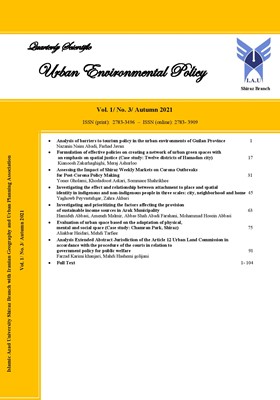Formulation of effective policies on creating a network of urban green spaces with an emphasis on spatial justice (Case study: Twelve districts of Hamadan city)
Subject Areas : Urban planningKianoosh Zakerhaghighi 1 , Meraj Ashurloo 2
1 - Associate Professor,, Hameadn Branch, Islamic Azad University, Hamedan, Iran.
2 - Department of Urban Planning and Design, Hamedan Branch, Islamic Azad University, Hamedan, Iran.
Keywords: Network Analysis, Urban Greenspaces, Spatial justice, Hamedan City,
Abstract :
Fair access to urban uses and their optimal use, especially urban green space, is crucial in sustainable development and social justice. Most cities, huge cities, face a shortage of green space and imbalance in this type of use distribution. The spatial distribution of these land uses is considered as one of the important criteria in achieving spatial justice and it seems necessary to study in this field. This study investigates the issuance of green space, emphasizing spatial justice in the 12 districts of Hamadan. This research is applied and based on the descriptive-analytical method. To collect information from different library and field methods, review and compile statistics and information from the detailed plan of Hamadan has been obtained. The results of the network analysis model show that due to the distribution and functional radius of parks in urban areas, population centers do not have fair access to the services of these parks. Considering the population of 525,791 people in the city, for regional parks 58%, district parks 44%, neighborhood parks 85%, and neighborhood parks 6% of the city area are within reach of these parks. According to the results obtained from this study, it is suggested that due to the high share of acquisition and its cost in the construction of urban parks, public lands located in the city should be given priority for green spaces and parks to solve problems related to land acquisition or private ownership. Also, in constructing new urban parks, urban areas that do not have green space should be considered.Extended AbstractIntroduction: The rapid growth of urban development in previous decades has led to an imbalance in how urban land is used. The rapid growth of cities can be considered one of the biggest environmental threats, the effects of which will be transmitted to the inhabitants of cities, ie humans, and will have a destructive impact on the soul and body of urban humans. Urban parks have a social, economic, and ecological role. With benefits such as treatment of mental illness, a favorable environment for raising children, social integration, and maintaining comfort, these parks are also considered indicators for improving the quality of living space and community development. Fair access to urban uses and their optimal use, especially urban green areas, is critical in sustainable development and social justice. The establishment of urban parks is worth studying to affect the quality of urban life and promote sustainable development and the non-return of capital and profits for municipalities. Most cities, especially large cities, face a lack of green space and imbalances in this type of use distribution.Methodology: This study aims to investigate the distribution of green space, emphasizing spatial justice in the 12 districts of Hamadan. Methodology: This research is applied and based on the descriptive-analytical method. To collect information from different library and field methods, review and compile statistics and information from the detailed plan of Hamadan has been obtained. The analytical way of this paper is also a network analysis model.Results: The results of the network analysis model show that due to the distribution and functional radius of parks in urban areas, population centers do not have fair access to the services of these parks. According to the population of 525791 people, the urban parks were first leveled, and then the urban blocks were leveled based on the amount of access to parks and green spaces. The results show that parks with the regional performance of about 216485 residents do not have proper access to regional parks; for district parks, 290335 people are out of access to district park services, parks with neighborhood performance of about 77292 city residents outside the service radius of these parks are. For regional parks, 58%, district parks 44%, neighborhood parks 85%, and neighborhood parks, 6% of the city area are within reach of these parks.Discussion: According to the results obtained from this study, it is suggested that due to the high share of acquisition and its cost in the construction of urban parks, government lands located in the city should be given priority for green spaces and parks to solve problems related to land acquisition or private ownership. And reduce costs. Also, in constructing new urban parks, urban areas that do not have green space should be considered.
_||_


